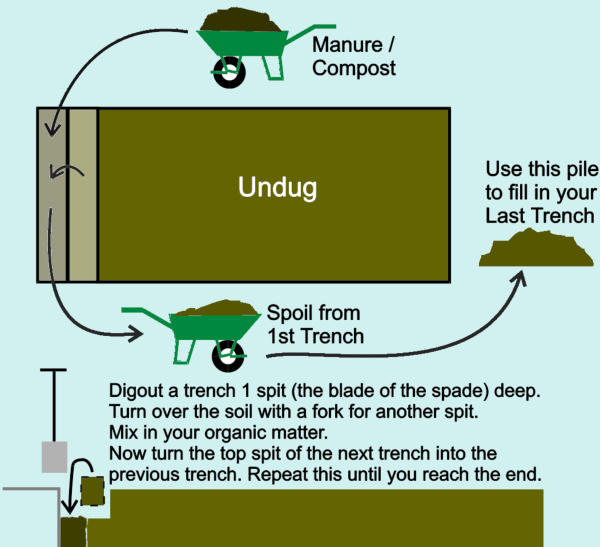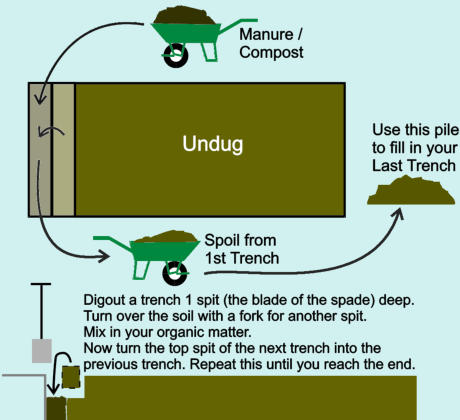
© Garden Cottage Nursery, 2022

Dig For Victory
Making A Border
Get Digging
Here we will outline a method of double digging that should give good results in most situations.
First you will want to get a good load of well rotted farmyard manure, it should be at least six months old. The manure will add
fertility and improve the structure of the soil.
Next mark out your border and strip the turf off.
Any lawn areas immediately around a border are subject to some degree of compaction by all the extra traffic they take as you are
preparing the border, to alleviate this aerate the lawn thoroughly first by repeatedly inserting a fork to ¾ of a spit and giving a little
waggle then pour coarse sand down the holes. As it is best to avoid walking on the grass put down some planks to better distribute
the weight.
Now dig out a trench 1’/30cm wide by the width of the border, or split it up into sections if this is more than about 4m wide.
Dig the trench to one spits (one spade blades) depth. Take this spoil and barrow it round to the far end of the border and dump it
just outside the area. Dumping it on an old sheet of plywood will make shovelling it up later easier and also leave less mess
behind.
Now fork over the bottom of your trench down to, if possible, a spits depth and mix in some well rotted manure, worms will
distribute this throughout the soil. Having the manure buried at the bottom means less of the accompanying weed seeds will
germinate. Well done, you have now dug the 1st of many trenches!
Now dig another one spit deep, 1’/30cm wide trench adjoining your first, this time turning it into the gap left by the 1st trench. Then
fork over the bottom and incorporate the manure in the same way as before. This process is repeated until you reach the end of
the border and you fill the final trench with the pile of spoil you dumped earlier from the first trench.
Now that you have a dug your border leave it for a few weeks to settle or if dug in autumn, overwinter.
Before planting roughly level the border with a push-pull rake and trample it, stepping along the surface in dolly steps. Finally rake
to a fine level. It is best to avoid walking on the soil as much as possible from now on as this will cause compaction. When planting
try to rest your weight on a scaffold plank which will disperse your weight over a wider area. Having a few discrete stepping stones
is a good idea in larger borders to give you something to go on when weeding, staking or pruning.
The hard part is over, continue to the next page for the fun part.


Dig deep
Classic border digging is done using one of three methods separated by how many spade depths (spits) you go down:
•
Single Digging
Soil is dug down and turned over to one spits depth.
•
Double Digging
Soil is dug down two spits depth and the deeper spits depth is worked over with the addition of organic matter. This is the
preferred method for borders.
•
Trenching
A heavy duty method going three spits deep. Useful for soils with a hard pan that impedes drainage and roots. Most
herbaceous plants don’t have very deep root systems, so trenching is generally overkill.











© Garden Cottage Nursery, 2021

Dig For Victory
Making A Border
Get Digging
Here we will outline a method of double digging that should give
good results in most situations.
First you will want to get a good load of well rotted farmyard
manure, it should be at least six months old. The manure will
add fertility and improve the structure of the soil.
Next mark out your border and strip the turf off.
Any lawn areas immediately around a border are subject to
some degree of compaction by all the extra traffic they take as
you are preparing the border, to alleviate this aerate the lawn
thoroughly first by repeatedly inserting a fork to ¾ of a spit and
giving a little waggle then pour coarse sand down the holes. As
it is best to avoid walking on the grass put down some planks to
better distribute the weight.
Now dig out a trench 1’/30cm wide by the width of the border, or
split it up into sections if this is more than about 4m wide.
Dig the trench to one spits (one spade blades) depth. Take this
spoil and barrow it round to the far end of the border and dump
it just outside the area. Dumping it on an old sheet of plywood
will make shovelling it up later easier and also leave less mess
behind.
Now fork over the bottom of your trench down to, if possible, a
spits depth and mix in some well rotted manure, worms will
distribute this throughout the soil. Having the manure buried at
the bottom means less of the accompanying weed seeds will
germinate. Well done, you have now dug the 1st of many
trenches!
Now dig another one spit deep, 1’/30cm wide trench adjoining
your first, this time turning it into the gap left by the 1st trench.
Then fork over the bottom and incorporate the manure in the
same way as before. This process is repeated until you reach
the end of the border and you fill the final trench with the pile of
spoil you dumped earlier from the first trench.
Now that you have a dug your border leave it for a few weeks to
settle or if dug in autumn, overwinter.
Before planting roughly level the border with a push-pull rake
and trample it, stepping along the surface in dolly steps. Finally
rake to a fine level. It is best to avoid walking on the soil as
much as possible from now on as this will cause compaction.
When planting try to rest your weight on a scaffold plank which
will disperse your weight over a wider area. Having a few
discrete stepping stones is a good idea in larger borders to give
you something to go on when weeding, staking or pruning.
The hard part is over, continue to the next page for the fun part.


Dig deep
Classic border digging is done using one of three methods
separated by how many spade depths (spits) you go down:
•
Single Digging
Soil is dug down and turned over to one spits depth.
•
Double Digging
Soil is dug down two spits depth and the deeper spits
depth is worked over with the addition of organic
matter. This is the preferred method for borders.
•
Trenching
A heavy duty method going three spits deep. Useful
for soils with a hard pan that impedes drainage and
roots. Most herbaceous plants don’t have very deep
root systems, so trenching is generally overkill.

























